2024 NBA Awards: All-NBA, All-Defensive and All-Rookie selections
Having made my picks for the individual hardware, I now drop-step flawlessly into the portion of the ballot that focuses on team awards: All-NBA, All-Defensive and All-Rookie. Let’s bake this ziti:
All-NBA
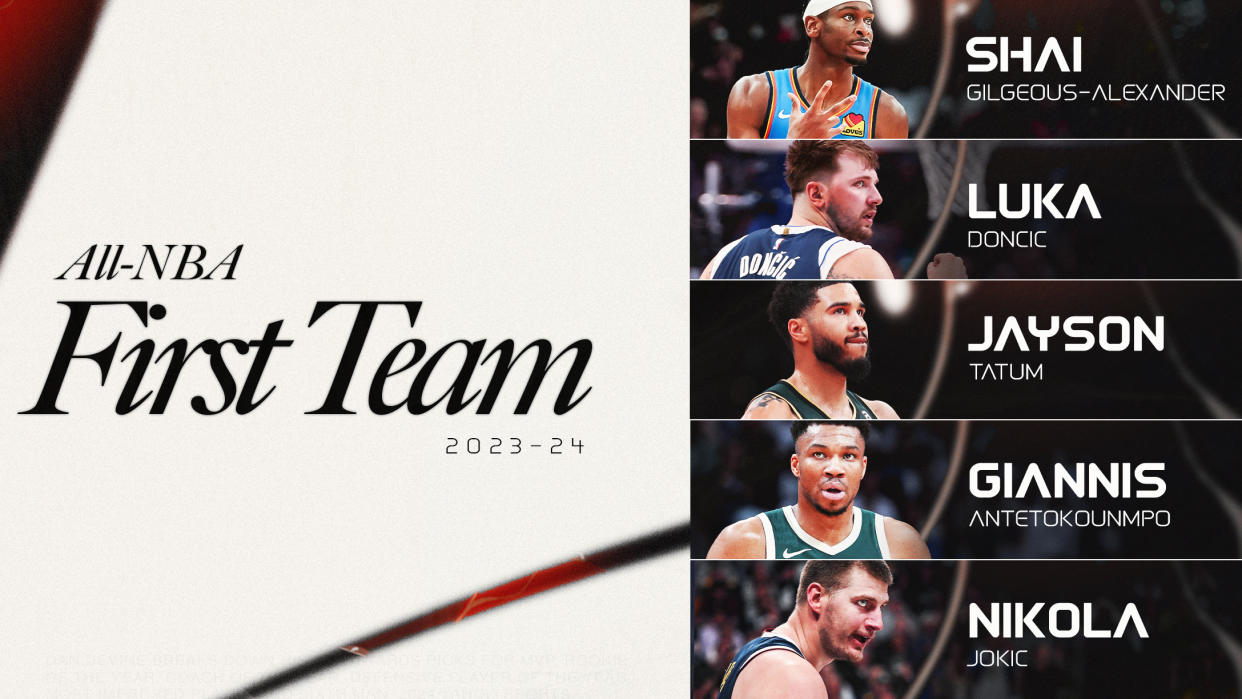
FIRST TEAM
Nikola Jokić, Nuggets
Luka Dončić, Mavericks
Shai Gilgeous-Alexander, Thunder
Giannis Antetokounmpo, Bucks
Jayson Tatum, Celtics
It’s funny: The NBA shifted to a positionless ballot structure so that we could get multiple centers on the First Team, better reflecting the all-that-is-old-is-new-again power dynamics of a league once again ruled by kaiju … and then Joel Embiid went on to miss more than half the season. In years past, that would’ve rendered the big fella unofficially ineligible, due to the infrequently discussed Most Voters Won’t Vote For A Guy Who Missed More Than Half The Season Provision. Now, it renders him officially ineligible, because of rules.
As luck would have it, my five-man Most Valuable Player ballot — which I detailed here — qualifies as a First Team … and, come to think of it, a pretty functional basketball team! Jokić as a stretch-5, Giannis as a playmaking 4 providing weak-side rim protection — kind of like Aaron Gordon with one of those mushroom power-ups from Super Mario Bros. — and Tatum at the 3; Luka and SGA sharing ball-handling duties, taking turns cooking defenders on switches and getting downhill in the pick-and-roll.
I am not sure everyone will be stoked at dramatically curbing their touches and shots to make it all work. But greatness requires sacrifice, you know?
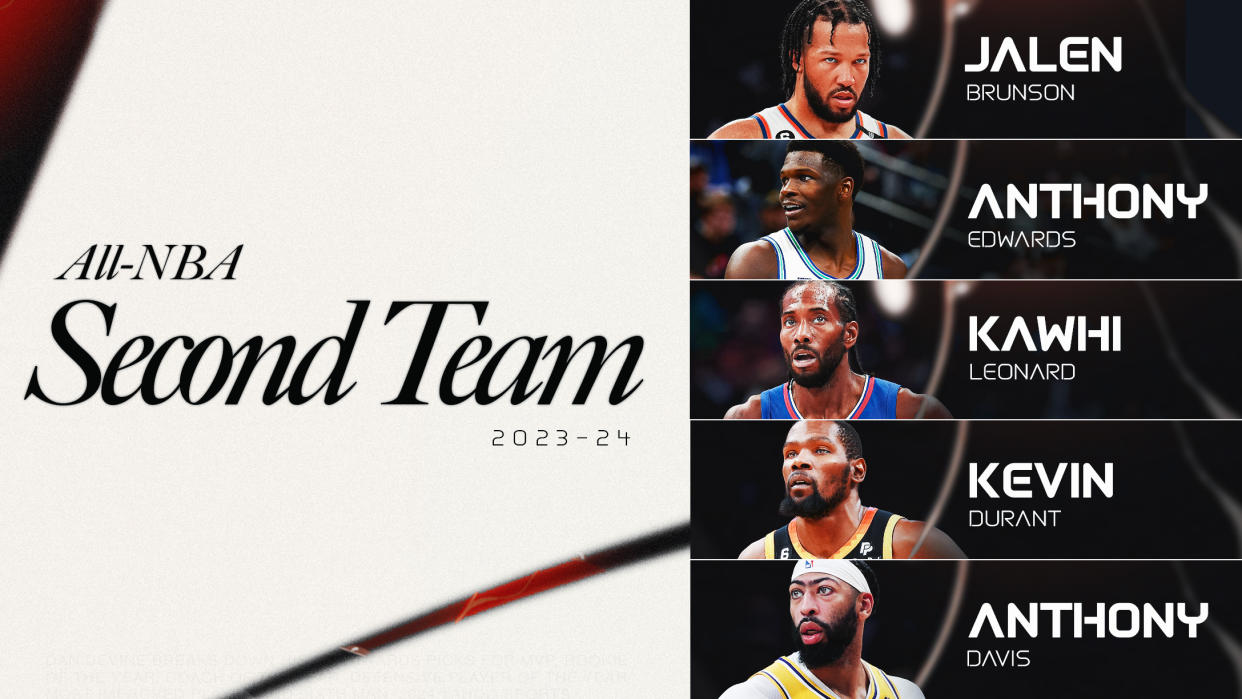
SECOND TEAM
Jalen Brunson, Knicks
Anthony Davis, Lakers
Anthony Edwards, Timberwolves
Kawhi Leonard, Clippers
Kevin Durant, Suns
Jalen friggin’ Brunson, man.
From an emotional perspective, Brunson is New York’s beating heart — the implacable, cinderblock-thick Energizer bunny whose entire game is predicated on the relentless commitment to Just Finding A Way. Through a more nuts-and-bolts lens, Brunson essentially is New York’s offense: Since Julius Randle suffered what would become a season-ending shoulder injury in late January, the Knicks have scored 121.8 points per 100 possessions with Brunson on the floor, according to NBA Advanced Stats (a mark that would rank second in the NBA over the full season), and just 101.6 points-per-100 with him off it (which would rank several sub-basements beneath dead last). They are in position to be the East’s No. 3 seed, with a not-insignificant chance to get up to second, because of him.
At the risk of belaboring a superstar breakthrough I’ve written about at some length before, here’s one more number:
Brunson is averaging 40 points and nine assists per 100 possessions this season, and doing it on an above-league-average true shooting percentage (which factors in 2-point, 3-point and free-throw accuracy). That is a combination of scoring volume, scoring efficiency and playmaking that only six players had ever reached before this season, according to Stathead: Michael Jordan, LeBron James, Stephen Curry, James Harden and Brunson’s old buddy, Dončić.
Hall of Famers: that’s the company that Jalen Brunson is keeping right now. He’s the best $104 million that James Dolan ever spent.
Like Brunson, Edwards built on a breakthrough 2022-23 season that saw him make his first All-Star team with an even more impressive encore.
The 22-year-old was one of just 10 players (minimum 1,000 minutes) to average at least 25 points, five rebounds and five assists per game this season. He bumped his shooting and playmaking efficiency up to career-high levels — and did it without taking a step back on the other end, where he’s played an important role in Minnesota boasting the league’s No. 1 defense all season — despite assuming the largest ball-handling workload of his career. That job got even tougher over the final month of the season, when the Wolves were without All-Star big man Karl-Anthony Towns and needed Ant to shoulder an even heavier burden; he did it, as he seems to do most things, with an effortless ease and élan, helping Minnesota stick the landing on its best regular season in 20 years.
On a per-minute basis, Davis’ scoring production dipped from last season; he also slid just a bit in a few advanced metrics, including estimated plus-minus and win shares per 48 minutes. But he still produced at an elite level — 24.5 points, 12.6 rebounds, 3.5 assists and 3.6 combined steals-and-blocks per game on .619 true shooting — while logging 700 more minutes than last season and topping 70 games and 2,500 minutes for the first time in six years. This season, AD was a top-15 scorer, a top-five rebounder and, in my view, a top-three defender — one of the best two-way players in the world and one of the 10 best in the NBA.
Like Davis, Leonard’s per-minute and per-possession production was down a tick from some of his previous high-water marks. Like Davis, he still played at a top-10 level on balance — and, to me, like one of the five best players in the game during the rampaging run that saw the Clippers go a scorching 33-10 from mid-November through the All-Star break — while also playing more games and minutes than he had since San Antonio. The bruising post play and downhill attacking, the automatic midrange pull-ups, the reminders of the all-world defensive game-breaking across multiple positions, the terrifying specter of him at the 5 when Ty Lue needs a small-ball finishing move … Kawhi’s complete suite of tools and skills is as awe-inspiring as any player in the league. Now we just need it on the floor in late April again.
As up-and-down as the season has been for the Suns, it perhaps went under the radar that Durant not only continued to produce with the same metronomic brilliance — 27.2 points, 6.7 rebounds, 5.1 assists and 1.2 blocks per game on pristine 52/41/85 shooting splits — but did so in the healthiest season he’s had since before he ruptured his Achilles tendon.
Preseason injury concerns turned out to be warranted, with Bradley Beal missing 30 games and Devin Booker spending a couple of stints on the sideline, limiting Phoenix’s much-ballyhooed new Big Three to barely 800 minutes together. KD, though, never faltered, maintaining a consistent presence on both ends of the court. Whatever the next few weeks tell us about the ceiling for these Suns, the last six months have shown us one thing: Durant establishes their floor. And, all things considered, it’s a pretty high one.

THIRD TEAM
LeBron James, Lakers
Stephen Curry, Warriors
Tyrese Haliburton, Pacers
Domantas Sabonis, Kings
Rudy Gobert, Timberwolves
It’s kind of mind-blowing that — at age 39, in his 21st NBA season — James played more than he has since his second stint in Cleveland. (And in the context of the same being true of Davis, Durant, Leonard and a number of other stars — as Ben Golliver of The Washington Post noted when we chatted on my podcast earlier this week — it also might be an indication that the 65-game awards threshold served its intended purpose.)
LeBron’s individual numbers — 25.5 points, 7.2 rebounds, 8.2 assists and 1.2 steals per game, shooting 59% on 2-pointers and a career-best 41.2% from beyond the arc — aren’t just historically unprecedented for a player of his age and experience; they’re also just really freaking good for anybody. He’s been the prime mover driving the turnaround of an L.A. offense that has been the NBA’s second-best attack over the last three months; in that span, the Lakers have scored nearly 12 more points-per-100 with James on the court than off it, benefiting from his facilitation from the post, his hard-charging drives in transition, and genius-level orchestration from the perimeter. I don’t know when LeBron will stop being one of the 15 best players in the NBA; I just know it wasn’t this season.
Ditto for Curry, in whose minutes the play-in-bound Warriors have scored at a top-five clip, and without whom scored like the 20th-ranked Bulls:
Curry topped 350 made triples for the third time in his career; only one other player (James Harden) has ever done it even once. No matter what’s going wrong in Golden State — Draymond Green’s paroxysms, Klay Thompson and Chris Paul fighting to reclaim what they’ve lost, Andrew Wiggins’ inconsistency, Steve Kerr’s uncertainty over how much/whether to lean on the youth, etc. — Steph remains the best answer.
That’s been particularly true in the clutch, where Curry has scored a league-leading 189 points in games where the score’s within five points in the final five minutes on obscene 50/47/95 shooting splits. The Warriors’ No. 2 scorer in crunch time? Thompson, with 57 points on 17-for-57 shooting. It’s not ideal to be so heavily reliant on one late-game scoring option; it’s pretty close to ideal, though, to be able to turn to one who is the greatest shooter, and one of the greatest playmaking forces, of all time.
Haliburton’s breakout season hit a speed bump in early January when he suffered a hamstring strain that sidelined him for the better part of three weeks and had him on a minutes restriction for several more. But the heights he reached during the first half of the season, when he was staking a claim as the best offensive player in the NBA while elevating the Pacers to national relevance, feel worth recognizing to me … especially because, even with his shooting numbers dropping off after the injury (though they’ve started to tick back up over the last few weeks) he’s still been one of the NBA’s most productive players overall.
Haliburton became just the third player to average 20 points and 10 assists per game on .600 true shooting in multiple seasons, joining Harden and Magic Johnson. He leads the NBA in assists and points created by assist per game, serving as the principal driver of an Indiana outfit that ranks second in the NBA in points scored per possession. He announced his arrival so authoritatively and memorably in the early going that, to me, he still belongs.
So does Sabonis, even as the injury-plagued Kings scuffle toward the play-in. He leads the NBA in rebounding and sits sixth in assists, serving as the forever-hunting hub of Sacramento’s offense. He led the NBA in triple-doubles, posted more double-doubles than anyone since the 1970s, played more minutes than anybody but DeMar DeRozan, and shot 59% from the floor. It might not feel like it, because there’s less overall positivity surrounding the Kings than there was during their run to the No. 3 seed last season, but Sabonis has been, on balance, even better than he was last season, when he finished seventh in MVP voting — a bedrock stalwart that Mike Brown could rely upon no matter who else was in the lineup, an organizing principle that makes the entire team work.
He is, in that way, kind of Offensive Gobert.
The biggest reason the Timberwolves have gone from the play-in tournament to a top-three seed in the Western Conference is that they own the NBA’s No. 1 defense; the biggest reason for that is Gobert, my pick for Defensive Player of the Year.
All of the things that have driven that improvement — better defensive rebounding and foul avoidance, allowing fewer shots at the rim and forcing more from midrange, a lower opponent shooting percentage at the rim — flow from Gobert’s presence, and his return to prominence on that end of the floor. Given that — Gobert’s central, and arguably primary, role in transforming Minnesota into a 55-win title contender — I kept coming back to the notion that he deserved a spot among the 15 best and most impactful players in the NBA this season.
The best argument I could make against it would be to put Jaylen Brown on the team, because the Celtics have been so much better than everybody else that they deserve two spots. I didn’t find that compelling. I think Boston’s been that good because it’s got a half-dozen of the 50 or so best players in the league; as well as Brown has played as an efficient and effective No. 2 option, I don’t think there’s either a statistical or anecdotal case that he’s been one of the top 15 this season. He’s the last cut.
Apologies to: Brown, Devin Booker, Tyrese Maxey, De’Aaron Fox, Paul George, Bam Adebayo, Zion Williamson, Victor Wembanyama.
All-Defensive
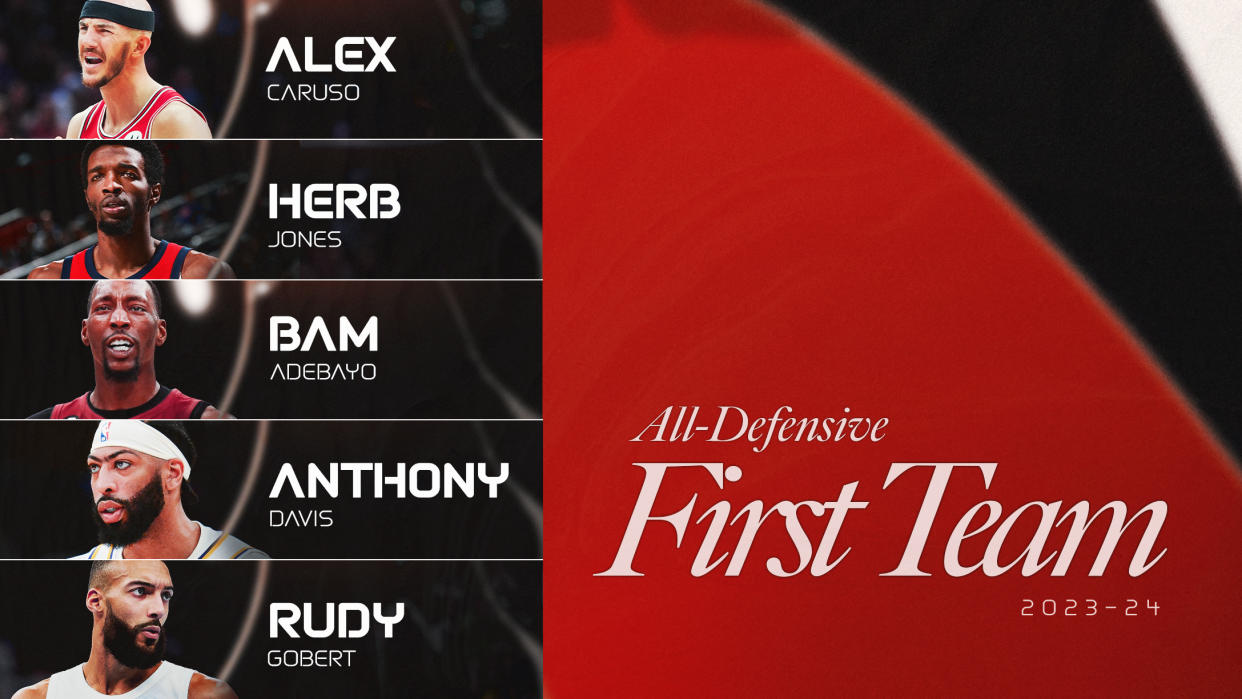
FIRST TEAM
Rudy Gobert, Timberwolves
Bam Adebayo, Heat
Anthony Davis, Lakers
Herbert Jones, Pelicans
Alex Caruso, Bulls
I made my cases for Gobert, Bam and AD on my Defensive Player of the Year ballot. That was yesterday, so I still think all of those things!
While the powers that be at the NBA also removed positional designations from the All-Defensive voting process, it didn’t sit right with me to just, like, put five centers on the First Team. Plenty of the most dangerous offensive threats in the NBA operate from the perimeter, and require special perimeter defenders to mitigate them; let’s make sure we give those guys their flowers, too.
Suggesting that Jones is solely responsible for New Orleans boasting a top-six defense in consecutive seasons would be uncharitable to the players who’ve either always been helpful on that end (Jose Alvarado, Dyson Daniels, Naji Marshall, Larry Nance Jr.) and those who have made strides to improve (Zion Williamson, Brandon Ingram, Trey Murphy III). But there’s no doubt that it’s Jones who leads the charge for the Pelicans, routinely blanketing the best wing weapons that the league has to offer, slithering around screens to contest every shot and pass possible.
It’s not just the nearly five combined steals, blocks and deflections per game. Or the fact that offensive players shoot about 4% worse than usual when Jones is on them — a top-20 mark among players to defend at least 500 shots. Or that the Pelicans defend at a top-two level with him on the floor to wreak havoc. It’s the way he forces opponents to work for everything …
Make defense cool again.#NotOnHerbpic.twitter.com/JMYSy29cjb
— Pull up shoot (@NElGHT_) February 24, 2024
… until forcing them to decide that discretion is the better part of valor.
Gregg Popovich on Herb Jones' defense:
"Avoid him like the plague. ... I'm serious. I told my guys, 'If he's there, pass it to someone else'."— Will Guillory (@WillGuillory) April 5, 2024
The same can be said of Caruso. (Well, except for the part about how saying he’s a one-man defense would be uncharitable.)
Caruso is an aggressive, communicative possession-disrupting menace: third in the NBA in steals, second in deflections, 17th in charges drawn and 30th in blocks. He does the lion’s share of the heavy lifting for a Bulls team that defends like the league-worst Jazz without him on the floor and like a top-10 unit with him cleaning everything up. No matter where he is — at the point of attack, one pass away on the weak side, down in the corner as the low man — he is always a threat to blow up an offensive possession with decisive help, a timely rotation or by just straight-up taking the ball. Whatever else might not work about the Bulls, that much does: When you need a stop, go get the guy in the headband.
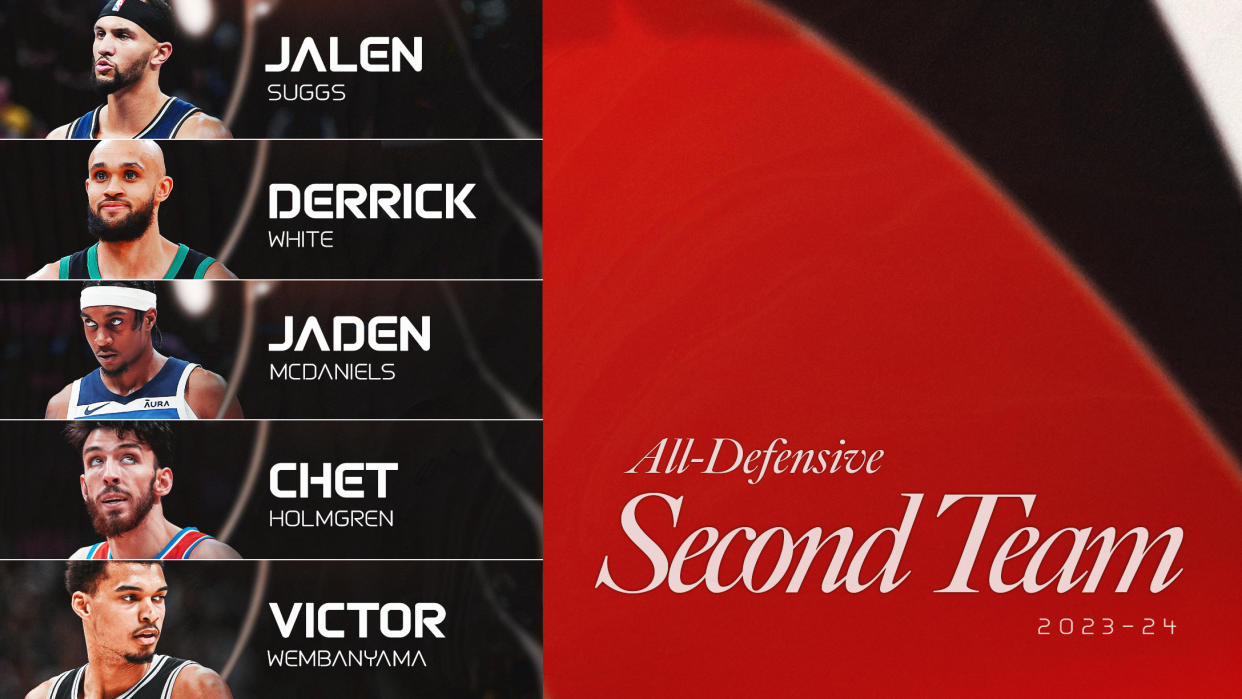
SECOND TEAM
Victor Wembanyama, Spurs
Chet Holmgren, Thunder
Jalen Suggs, Magic
Derrick White, Celtics
Jaden McDaniels, Timberwolves
I hit on Wembanyama’s case in both the Defensive Player of the Year and Rookie of the Year sections of my individual awards ballot. And, at the risk of turning these two into a Force dyad, I discussed Holmgren’s a bit, too, because I think it’s a pretty good one:
— . (@hoops_vids) November 9, 2023
It’s reasonable to argue that Oklahoma City’s elite defense is a whole greater than the sum of its parts — the synergistic result of putting multiple excellent perimeter defenders (Luguentz Dort, Shai Gilgeous-Alexander, Jalen Williams, Aaron Wiggins, Cason Wallace) on the floor together. I think it’s also reasonable, though, to look at the Thunder’s jump from 16th on that end last season to fourth this year — and at the fact that OKC has been 1.3 points-per-100 stingier in minutes played by the dude who’s fifth in the NBA in blocks, second in contested shots and 10th among high-volume defenders in field-goal percentage allowed at the rim — and conclude that the 7-foot spike-strip that all those wing stoppers are funneling their guys into matters quite a bit, too.
The story is similar for White, first among equals as the shot-blocking, pressure-packing, eminently switchable point-of-attack ace for the Celtics’ third-ranked defense. And for Suggs, the perfect attitudinal avatar for Orlando’s No. 2 unit — forever in ball-handlers’ jerseys, his chin in their chests, making them feel him all over the floor. And for McDaniels, who has the benefit of playing in front of Gobert, but whose 6-foot-10 frame, all-encompassing wingspan and capacity to smother wings before they even get to the paint makes life a hell of a lot easier on Gobert, too.
Apologies to, in no particular order: Isaiah Hartenstein, the unsung hero of the Knicks’ playoff run; Kawhi Leonard; Brook Lopez; Fred VanVleet and Dillon Brooks in Houston; SGA; Kentavious Caldwell-Pope and Aaron Gordon in Denver; and Joel Embiid, Jonathan Isaac and OG Anunoby, three guys who have played at All-Defense levels whenever they’ve been on the court this season … but who just haven’t been on the court enough this season.
OK, let’s finish strong:
All-Rookie
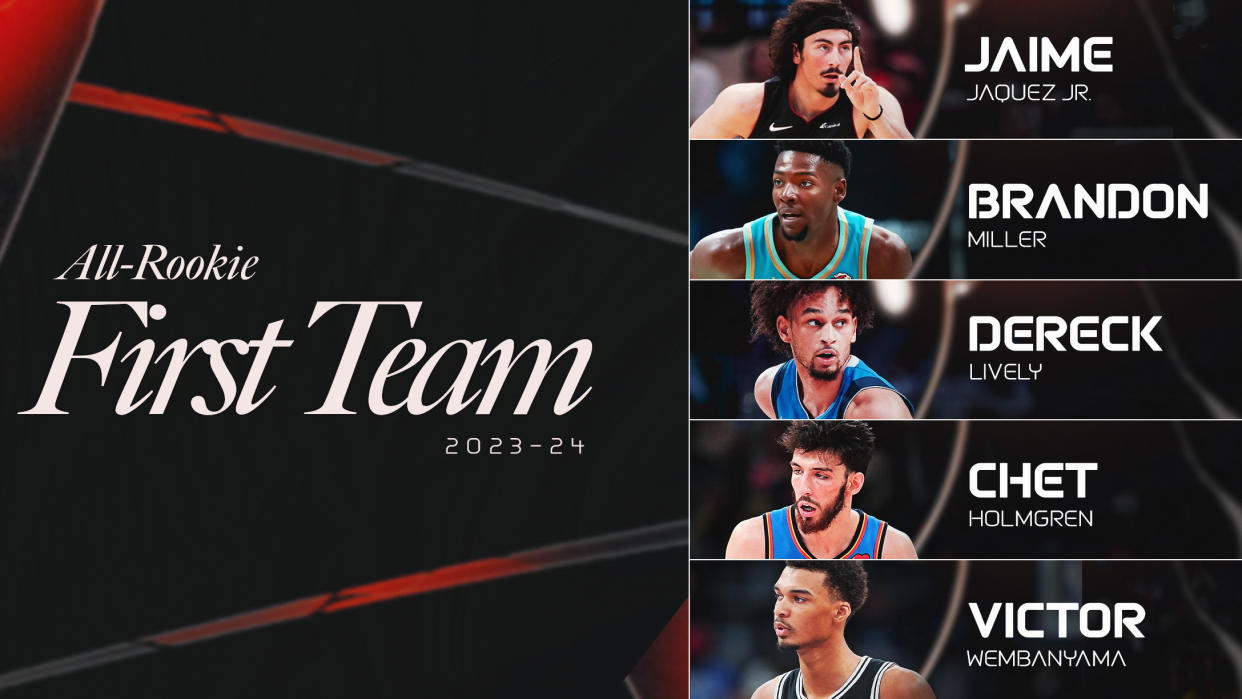
FIRST TEAM
Victor Wembanyama, Spurs
Chet Holmgren, Thunder
Brandon Miller, Hornets
Jaime Jaquez Jr., Heat
Dereck Lively II, Mavericks
Wembanyama, Holmgren and Miller — the top three finishers on my Rookie of the Year ballot — get the first three First Team spots. They’re joined by Jaquez, who walked into the NBA as a plug-and-play real-minutes role player for a Heat team that’ll make the postseason, averaging just under 12 points, four rebounds and 2.5 assists per game on 49% shooting while holding his own on defense across multiple positions.
The fifth slot goes to Lively, who made an immediate impact as a lob-flushing, rim-running, paint-protecting 7-foot-1 complement to Dončić and Kyrie Irving, averaging 9.2 points, 7.8 rebounds, 1.5 blocks and 1.3 assists in 25.7 minutes per game before the All-Star break. And while he’s given way in Dallas’ starting lineup to trade-deadline addition Daniel Gafford over the last two months, the Duke product continued to make his presence felt as a high-motor reserve with great mobility on defense, good vision and touch as a connective passer, and a propensity for finishing damn near everything he can get his hands on:
— MavsHighlights (@MavsHighlights) March 14, 2024
That Kyrie to Dereck Lively II connection 😮💨 pic.twitter.com/aQ3nq6vcX3
— NBA TV (@NBATV) March 17, 2024
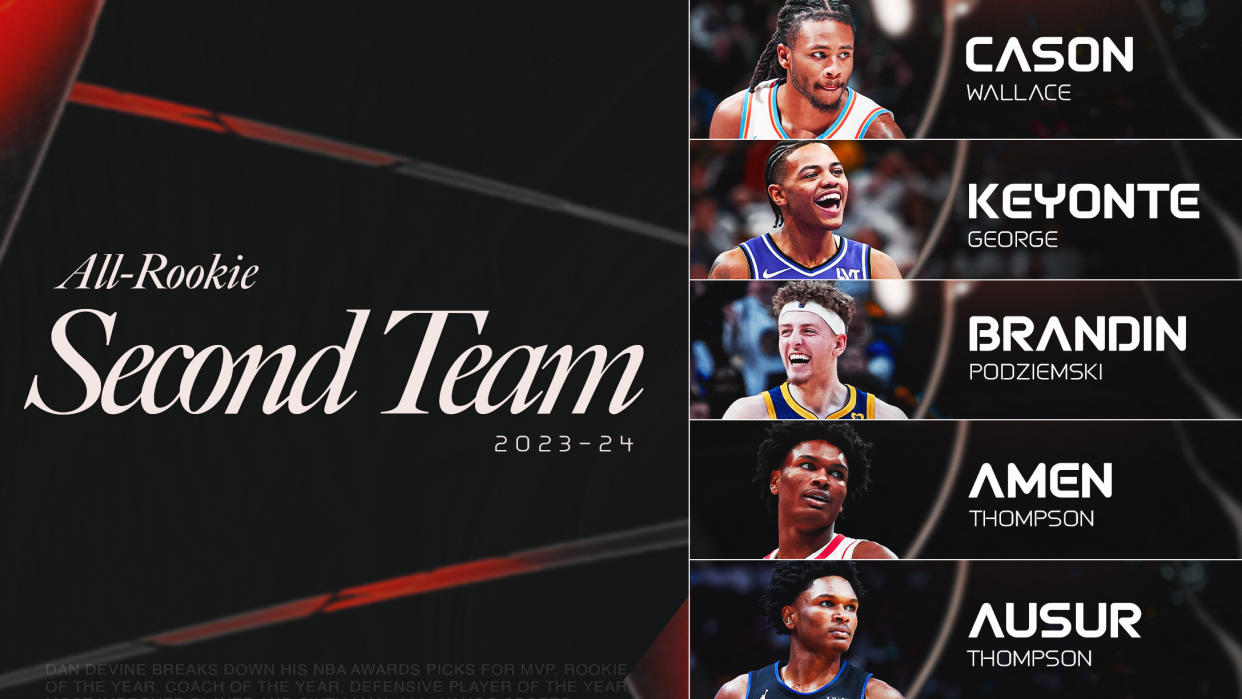
SECOND TEAM
Amen Thompson, Rockets
Ausar Thompson, Pistons
Brandin Podziemski, Warriors
Keyonte George, Jazz
Cason Wallace, Thunder
It took a while — things were a little hectic in Golden State early in the season, after all — but Podziemski worked his way into rotation minutes, and even 28 starts, for Steve Kerr by attacking the glass (the only rookie guards since 1970 with a higher rebounding rate were Dončić and Ben Simmons), taking care of the ball (3.1-to-1 assist-to-turnover ratio) and defensive versatility in the backcourt. George is taking his lumps as the lead guard of a Jazz team that, for the second straight year, deliberately aimed for the basement at the trade deadline, but he’s shown flashes of shot creation, shot-making and off-the-bounce playmaking juice that mark him as a keeper in Danny Ainge’s rebuild in Salt Lake City:
Wallace’s shooting has dipped since I praised his consistency last month (naturally). But he’s been a ready-made contributor in Oklahoma City’s guard rotation, earning Mark Daigneault’s trust with his defensive effort and steady, low-turnover play on the ball. And while “steady” might not be the first word I’d pick to describe the Thompson twins, “effort” would certainly be up near the top of the list:
ausar thompson does never before seen things on defense nightly. what a player pic.twitter.com/Qj7RTgbA3Z
— ben pfeifer (@bjpf_) November 16, 2023
Amen Thompson was HUGE in tonight's OT win!
📊 25 PTS | 15 REB pic.twitter.com/JCdvrxOhNN— Houston Rockets (@HoustonRockets) March 28, 2024
Only two other rookies in the last 40 years have combined rebounding, facilitation, shot-blocking and steal-snagging to the degree that Amen and Ausar have: Jokić and Wembanyama. Pretty decent company. The Thompsons might both be a jumper away from stardom, but they already impact the game in a way — and with an electricity and joy — that marks them as prospects worth getting really, really excited about.
Apologies to, in no particular order: Toumani Camara, Duop Reath and Scoot Henderson in Portland; Trayce Jackson-Davis of the Warriors; GG Jackson, one of the brightest spots in a pretty dark season in Memphis.
